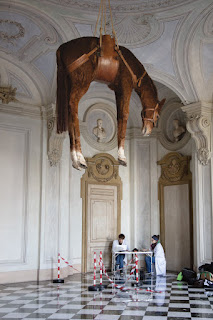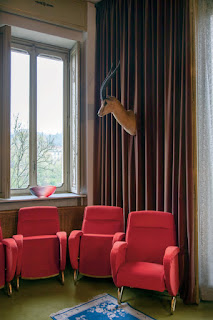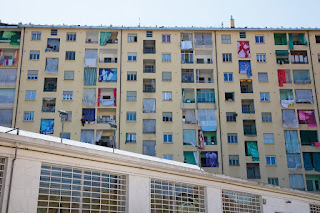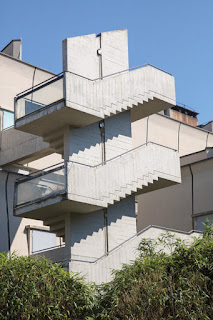The Ghosts of Turin
TURIN AT A GLANCE is a grid. The fourth largest city in Italy, it's distinguished from the others (baroque Rome, wild Naples) by the rigidity of its plan, an inheritance from its origins as a Roman military camp. It's difficult to get lost here, but also hard to appreciate the particularity of any one area, given its impressively refined sameness. Once the seat of the country's aristocracy, the Savoys, the city still bears the impress of the family's stiff, uncompromising dignity. An almost suffocating elegance suffuses it, every orthogonal street a sheer face of mute, balconied 18th-century facades, each wonderfully preserved in a kind of aristocratic amber.
"What a dignified and serious city!" exclaimed Friedrich Nietzsche on first acquaintance in the late 19th century. He admired the view of the Alps and the soft, variegated, constantly shifting light: "I would have never thought that the light could make a city so beautiful." Moody spring rains descended for much of the week I was there, but I took shelter in the long and porticoed cafe-filled arcades radiating from the Palazzo Reale in the city center — instituted by the monarchy to ensure the royals would never themselves suffer from dampness on their passeggiata. On clear days, the mountain air was sweet and cool.
In the 20th century, aristocratic restraint became middle-class self-abnegation. Turin would come to be known as an industrial city, above all the home of Fiat, symbol of the Italian economic "miracle" of the 1950s and 1960s; the factory of Mirafiori toward the south of the city eventually became the largest automobile factory in Europe. Italian radio and television is encapsulated here in the Modernist slab that houses the Turinese home of Radiotelevisione Italiana (RAI) — the Italian state station — in the city center. Turin's atmosphere of cool detachment and class division received its most perceptive treatment in "Le amiche" ("The Girlfriends"), the 1955 film by Michelangelo Antonioni, which takes full advantage of the city's hyperreal polish. A rich woman flirts with an architect's assistant, but can't commit to him because of his low-class background. "We would just fight about furniture," she admits.
Today, the association of the Turinese with a quiet, relentlessly hardworking attitude is proverbial. The mythos of the relentless but demure city persists in the observations of contemporary residents. "Everyone works hard," the gallerist Franco Noero told me. Elisa Troiano, of the new avant-garde artist space Cripta747, described the city as "protective of itself, very closed" — an aspect the artist Lara Favaretto, who moved to Turin from Milan many years ago, called " 'congealed.' ... Nothing happens, nothing happens, nothing happens," she added sardonically, in between cigarette puffs.
Continue reading the main storyOn the surface, nothing does seem to happen. Late at night, the city center is calm, most restaurants closed, the occasional late-night bar spilling out with patrons, whose shouts are distinct in the muffled air. But with typical quiet and primness, Turin has over the last 10 years remade itself into a city prized as much for the arts as for its now-diminished industrial prowess. In addition to its storied museums — Palazzo Reale, the storehouse of the Savoy treasures; Museo Egizio, one of the largest collection of Egyptian works outside of Egypt — it has a surprising number of galleries and art foundations, many of them in former industrial spaces.
The idea of an artistic destination shrouded by a royal and manufacturing city was in accord with one of Turin's other notable features: its weird association with magic, madness and the occult. Here was where a troubling number of artists and philosophers had suffered crippling depressions or existential crises, or had gone crazy: the epic poet Torquato Tasso; the young Jean-Jacques Rousseau; the novelist Primo Levi. It was on or near the wide, trolley-crossed thoroughfare Via Po where Nietzsche famously saw a horse being maltreated, rushed to embrace it and then collapsed, suffering a fit of madness from which he would never recover.
The occult is, it seems, hidden in every corner of the city. Along the Via Po are Turin's many antiquarian bookshops, hawking old treatises on witchcraft. The symbol of the city is the Mole Antonelliana, a superbly weird and violently ill-proportioned tower, stacked with alternating tiers of minuscule colonnades, swelling to a quadrilateral roof and rising with an aluminum spire to the height of 547 feet. In the San Salvario neighborhood, south of the city center, one finds a museum dedicated to Cesare Lombroso, the 19th-century criminologist who believed that a tendency to crime was an evolutionary throwback, "atavism," which could be determined by heredity; his wrongheaded, dangerous and, for a time, powerfully influential research is preserved in the museum's incomparably creepy store of death masks and skull-measuring instruments.
"I want to say that Turin is not a neutral city," the Turinese author Giorgio De Maria said in a 1970s interview; his cult novel, "The Twenty Days of Turin," from 1977, has just been published in English. "Even if you don't outwardly know anyone and no one knows you, you always get the impression you're being watched."
During my visit, more than a few people asked if I knew that Turin was the only city to occupy the geographic intersection of the black magic and white magic triangles, and is therefore caught in an eternal struggle between the forces of good and evil.
THE FIRST TIME THIS question was posed to me, I was standing in the apartment of Carlo Mollino, a renowned architect — also a daredevil and private pornographer — who died in 1973. This was his last residence, which he never lived in, because Mollino planned it to be a project confronting death, symbolic of his own posthumous journey, as the pyramids were to the Egyptian pharaohs. My questioner, the small museum's eccentric caretaker, Fulvio Ferrari — wearing an extraordinary dark vest patterned with giraffe motifs — had been showing me around the apartment, demonstrating its myriad varieties of occult significance. Before the entrance to the balcony were two giant clamshells, signaling the birth of erotic love (Ferrari helpfully pointed me to a photocopied image of Botticelli's "The Birth of Venus"), and oval mirrors signifying eggs and wombs.
In a study, there were drawers filled with Polaroids of nude women, taken by Mollino. They wore clothes he had collected over decades, adopting comically lascivious poses. The one in the wedding dress, Ferrari told me, was intended to symbolize the bride that Mollino never had, but would enjoy in the afterlife. The ones in black lingerie, he added, opening another drawer, were representations of courtesans. Here, too, Mollino was following the tradition of the pharaohs.
Mollino, who was born in 1905, represented almost perfectly the two faces of 20th-century Turin. On the one hand, he was a respected professor in the University of Turin's Department of Architecture, the son of a stolid engineer from whom he learned the importance of sound mathematical and mechanical principles in construction. His sui generis furniture — each piece designed for himself or particular clients, not for industry — reflected assiduous ergonomic principles. On the other hand, he was a fierce, dangerous child of pleasure, obsessed not just with women's anatomies but with racing cars and aerobatic aircrafts. (He made designs for both.) I visited the Teatro Regio, the city's opera house, which he designed in 1965, and found the same obsessive features repeated, all the more scandalous for their association with this most hallowed of bourgeois rituals. The shape of the entire complex was meant to be that of an hourglass torso, while the plush, red-lined interior was made deliberately uterine, with ovarian and egglike motifs scattered throughout. The stage itself was a giant oval, on which I saw Puccini's Manon Lescaut sob out her final aria — "Sola, perduta, abbandonata!" — as she crept across a barren landscape toward death.
Mysteries upon mysteries prevailed in the Casa Mollino. Fulvio and his son — the improbably named Napoleone — had become caretakers in the 1990s, after having acquired the apartment from its previous resident, an engineer. By that point, Mollino's own designs had dissipated and had to be restored, partly through acquisitions from Mollino's living friends. It was in some sense a reinvention of an invention: an apartment designed to be a mausoleum, turned into an apartment and reconverted to a mausoleum by admirers of Mollino, who had themselves never met the man. This trajectory was not unlike contemporary Turin itself: a monument to ghosts made functional, only to be changed once more back into a monument.
Continue reading the main storySOMEWHERE between occult Turin and stuffy bourgeois Turin — though not unconnected with either — is artistic Turin. And the artistic version is linked, in space and time, with the working class. During the 1950s and 1960s, the city became the site of one of the largest mass migrations in Italian history, as thousands moved from the country's hardscrabble south to find work in the industrializing north, above all in the factories of Fiat. The history is manifest in the wide expanse of the city's peripheries, where outsize warehouses, many of them apparently unused and empty, are interspersed among the crush of apartments.
But the real transformation was internal to the millions who labored on the assembly lines at Mirafiori and elsewhere. In Nanni Balestrini's 1971 novel "We Want Everything," the life of a southern émigré turned Fiat worker reflects bitterly on the conditions of the factories. "Only a drone," he says, "could spend years in this ... prison and do a job that destroys your life." Throughout the 1960s, workers organized and fought against their employers in a series of dramatic strikes. It was a city in tremendous ferment. The Turinese "outsider" artist Carol Rama — subject of a number of exhibitions this year, in Venice and at the New Museum in New York — was an early progenitor of its growing atmosphere of cultural revolt.
Rama, a friend and neighbor to Mollino, is said to have had her first exhibition of drawings, in 1945, shut down by the police for its sexually aggressive imagery (such as men practicing bestiality). Later works were installations drawing on the products of the city, and her personal connection to them. Several used flattened bicycle tire tubes, flayed and hung, referencing her father's factory, which had gone bankrupt. Collected by admirers and renowned among fellow artists, she nonetheless stood apart from artistic fashions in the city, even as she anticipated others. "Dear Franco," she wrote in a note presenting her friend, the art publisher Franco Masoero, with a drawing, "we are geniuses. The rest can go to hell."
In the late 1960s, the political convulsions in Italy made their most lasting artistic contribution through a hallowed series of exhibitions of mostly Turinese artists. There was a long pot filled with beeswax, melting under the weight of a neon sign with the phrase "Che Fare?" — "What Is to Be Done?" (a reference to Lenin). There were bowls filled with salt; a braided steel-wool bridge. Organic materials were mixed effortlessly and surprisingly with industrial ones. Seeing these installations, the critic Germano Celant coined a phrase for a movement that would emerge as Italy's most important in the 20th century: "poor art," or "arte povera."
The Arte Povera artists — among them Giulio Paolini, Mario Merz, Marisa Merz, Michelangelo Pistoletto, Jannis Kounellis, Gilberto Zorio, Giovanni Anselmo and Alighiero Boetti — differed widely in their aims and styles, but they appeared united in their attempt to create art out of a wider variety of media — temporal in nature, and concerned with tactile and olfactory possibilities — than their Conceptual and Minimalist coevals.
Most of the Arte Povera artists were based in Turin, and their improvisatory style had a lasting impact on the artistic infrastructure of the city. Carolyn Christov-Bakargiev, a curator who wrote an important study of Arte Povera, is now the director of the city's two major modern art museums, the GAM Galleria Civica d'Arte Moderna and the Castello di Rivoli Museo d'Arte Contemporanea, which has a renowned collection of Arte Povera. She considers Turin in the 1960s as violently creative an artistic city as Florence in the Renaissance. In her spacious office in the Castello — a spectacular Savoy castle converted in the 1980s into the country's first contemporary art museum — she situated Arte Povera in the 1960s climate of social experimentation. As Christov-Bakargiev drew on a notepad while making her points, her dog, Darcy, gnawed at my pant leg. "You know about the black triangle and the white triangle?" she said, drawing both.
Continue reading the main storyThe association of Arte Povera with the city is endlessly visible. The Fondazione Merz is one of the central art spaces in Turin: a former industrial warehouse now given over to the archive of Mario and Marisa Merz. At the center of the Spina Centrale, one of the city's major thoroughfares, lies a neon and stone igloo fountain by Mario Merz: a characteristic shape from an artist long concerned with images of shelter. Del Cambio, Turin's most storied restaurant — dining haunt of Savoys as well as of Nietzsche, Maria Callas and Audrey Hepburn — gave over one of its rooms to Pistoletto, who painted brightly colored profiles on mirrors of Turinese patrons, staring out into the adjoining Piazza Carignano.
But Arte Povera has also seeded the city in deeper ways. Two of the city's prominent gallerists partly owe their careers to it. One is Franco Noero, former assistant to Gian Enzo Sperone, the movement's strongest supporter. Noero then founded a gallery in Turin's Fetta di Polenta in 2008, an exceptionally tall, narrow building near the northern edge of the city center. He staged several legendary shows there, before eventually moving to a warehouse in the working-class neighborhood of Barriera di Milano, in a light-filled former car-styling garage, where he now represents several internationally renowned artists, including Simon Starling, Lothar Baumgarten and Lara Favaretto.
Favaretto complained to me that "everyone is still doing 'Arte Povera.' " Her work plays with disintegration over time. "The Man Who Fell to Earth," 2016, consists of two cubes of bright confetti, purple and red, which gradually fall apart — the confetti encircling the work like dust.
BY THE 1980S, Turin, like Detroit, was suffering from the same forces that were undoing all the old automotive cities. Fiat factories began shedding workers in the thousands. But the artistic inheritance of the city remained; factories were gradually converted to other uses, very often devoted to the visual arts. Atop the colossal Fiat building of Lingotto, now a depressing mall, one finds the Pinacoteca Giovanni e Marella Agnelli, a museum devoted to the nonpareil collection of the Agnelli family, the owners of Fiat. Standing in front of Giacomo Balla's "Velocità astratta," 1913, with its Futurist waves of pummeling speed, there is a certain melancholy in being able to look out onto Lingotto's rooftop, still paved with the curving asphalt where Fiat used to test its cars.
The dwindling industrial heritage along with the burgeoning arts scene are only the latest version of the city's Janus-faced character. In 2006, Turin and its region played host to the Winter Olympics, providing an excuse to clean streets and revamp the city's image. Over aperitivo and snacks at a bar in one of the city's porticoes, Carlo Capello, an anthropologist at the University of Turin studying unemployment in former Fiat neighborhoods, told me that, since the Olympics, a general discourse of a "changing city" had come into being, centered around the arts. This language had settled in, despite the persistence of real poverty: Twelve percent of the city's residents and 40 percent of its youth were unemployed, the highest level in northern Italy. "The center of the city has seen a lot of investment," Capello said. "It's insulated from the periphery."
In 2016, the peripheries had their revenge in the form of a political earthquake: The ruling center-left Democratic Party was defeated by Chiara Appendino, a young candidate from the populist Five Star Movement. She had run a campaign emphasizing a city "divided in two," as she noted in an advertisement. "On one side are the lines in front of the museums," she said. "On the other, the lines in front of soup kitchens."
The growing divide between the art-focused and industry-focused cities may be irreconcilable. But in the gap, new institutions have emerged that take advantage of both. Cripta747, which is located in the immigrant and working-class Barriera di Milano, once occupied the basement of Franco Noero's nearby gallery, before finding a space of its own in 2015 in a warehouse. I spoke to Troiano and her co-founder, Renato Leotta, outside of the nondescript building, as they prepared for a panel discussion they were hosting on the new philosophical current of "speculative realism." When I asked them about the possibility of their contributing to the gentrification of the depressed neighborhood, Leotta bristled. "I'm quite critical of the idea, we're not interested in that," he told me. Instead, they found more value in the actually open-ended artist residencies, where the artists benefit from the local manufacturing expertise. Around us, in active warehouses, workers were moving around on forklifts.
That had always been the hope of the arts in Turin: its uneasy and never stable amalgam of aristocratic connoisseurship, bourgeois finance and working-class know-how. The question is whether, under its current conditions, it might be resurrected, on a more egalitarian basis. I chatted with Cripta747's two current artists in residence, Sebastiano Impellizzeri and Corinna Gosmaro, both of whom were attracted to the city's cheapness and the sheer number of artists. It allowed for a "stimulating exchange with others," Gosmaro said. Impellizzeri, a painter who had moved from Sicily, waved a cigarette in the darkening air, and lauded the beautiful light of the place, which gave it "a real atmosphere for painting," he said. As he spoke, I had to dodge a forklift that was trundling toward me. I thought of Nietzsche's line — "I would have never thought that the light could make a city so beautiful" — which he wrote only some weeks before losing his mind. Did the painter know, I wanted to ask, about the white triangle and the black triangle?
A version of this article appears in print on May 21, 2017, on Page M2133 of T Magazine with the headline: Beyond Good and Evil. Today's Paper|Subscribe
| Evernote helps you remember everything and get organized effortlessly. Download Evernote. |















No comments:
Post a Comment